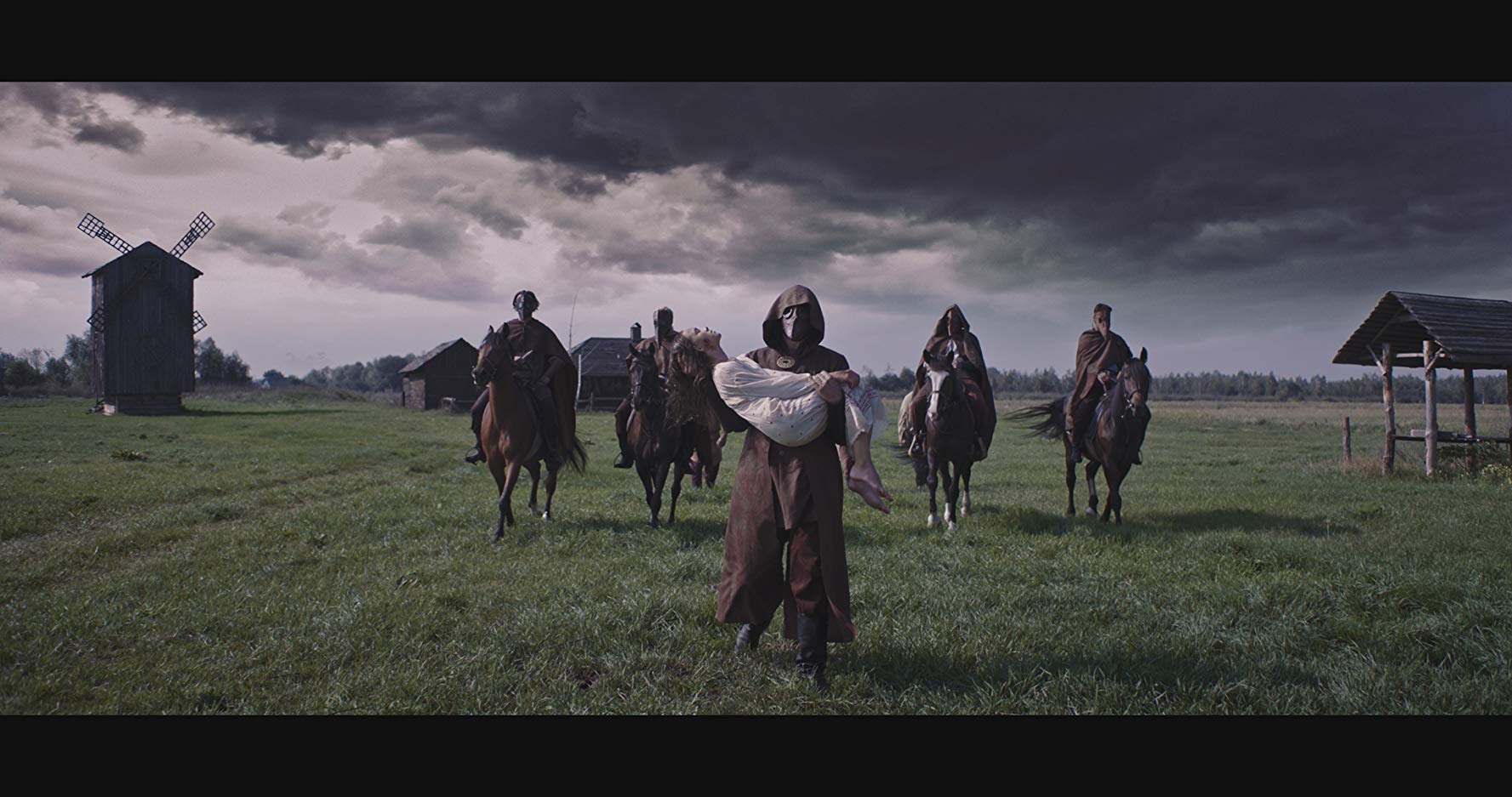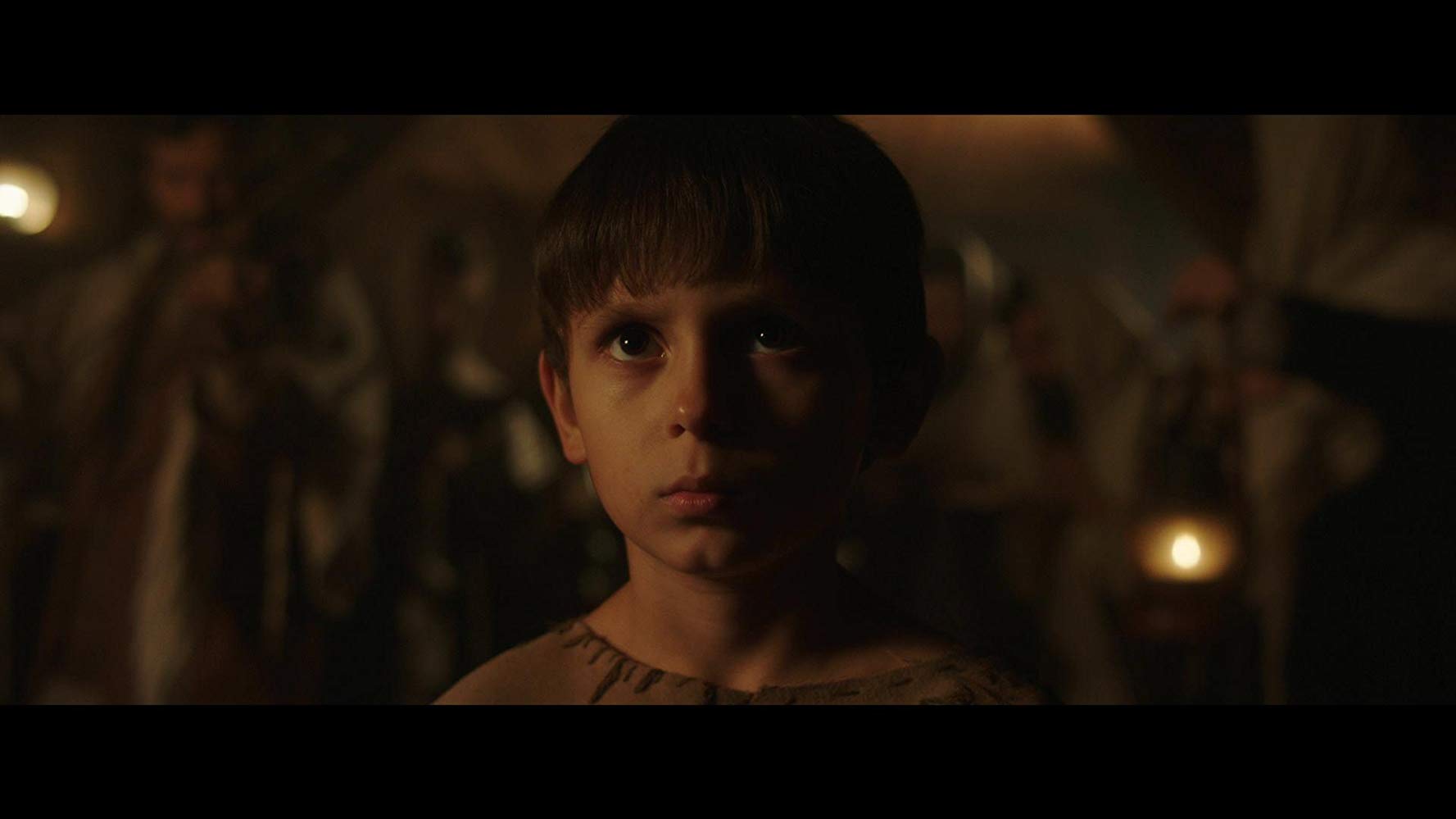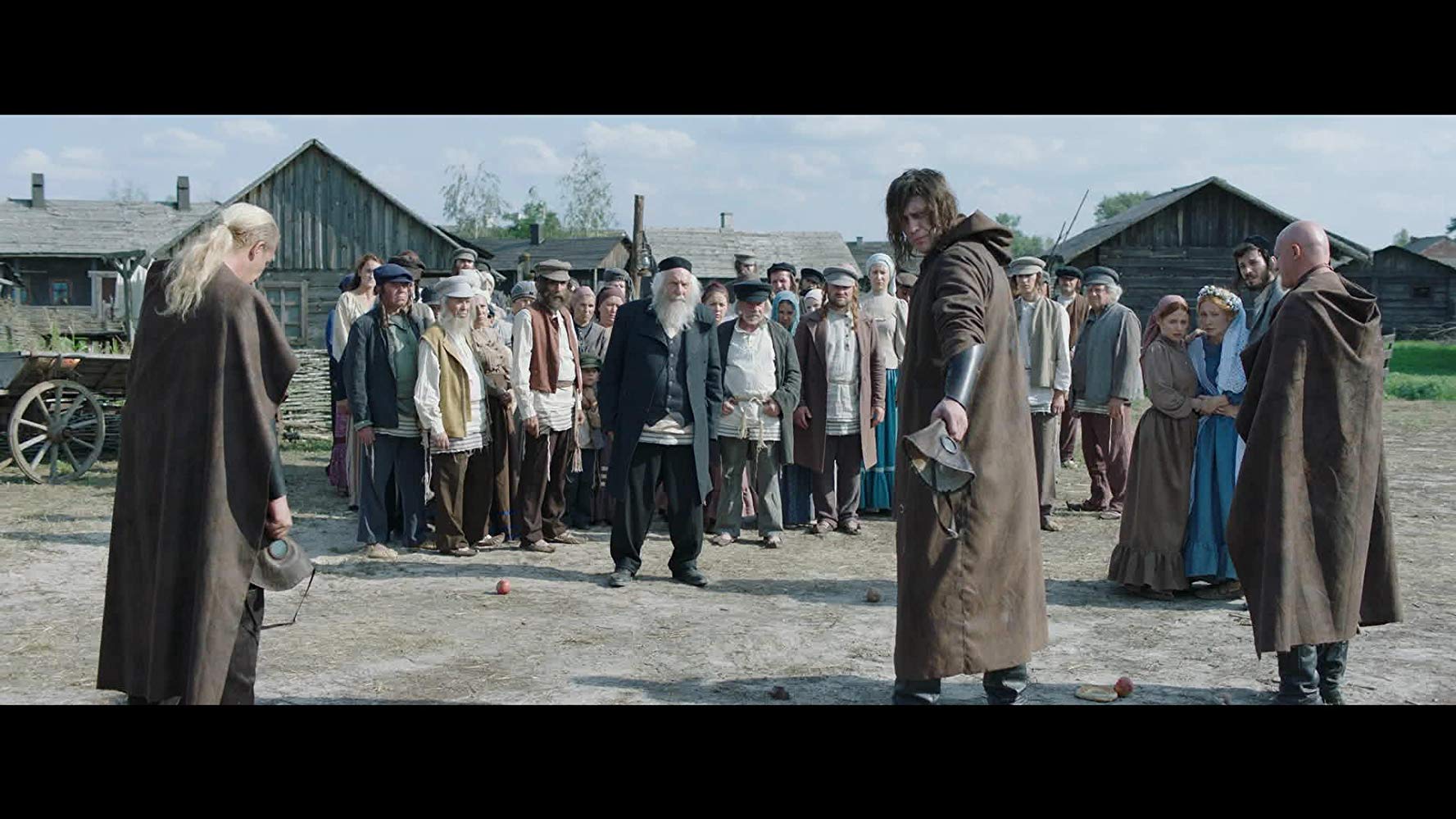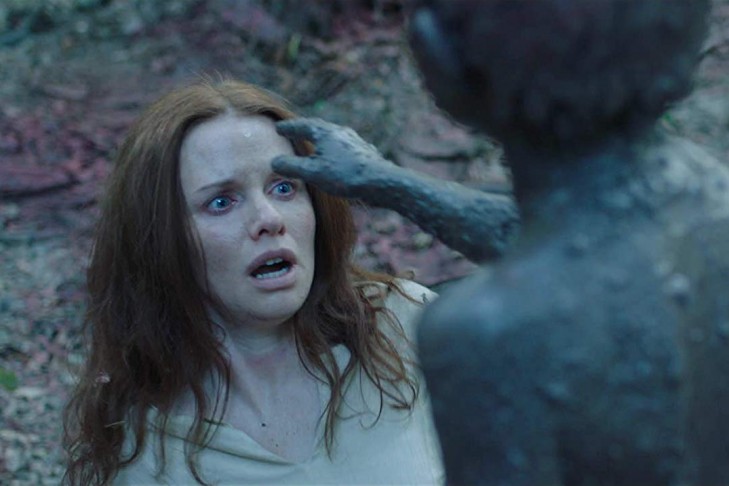Last week, my colleagues Ashley, Dan, Kali and I sat down to watch a new cinematic take on the golem story. I know what I had hoped to get out of this experience personally: gleeful yet righteous vicarious violence. That is, after all, the primary point of a golem—to enact bloody justice against anti-Semites. Sadly, 2018’s “The Golem” film, streaming now, perplexingly minimizes that fun to give more screen time to golem-on-Jew violence, which is precisely not what I tuned in for. Did you ever imagine you’d see a movie wherein a golem stabs a rabbi in the thorax with a shofar? No? Neither did we.
The film opens with a twist on the OG golem of Prague story from Jewish folklore. The Maharal, Rabbi Judah Loew Bezalel, has created a golem out of clay to defend the Jews of the Prague ghetto from anti-Semitic pogroms born of a blood libel. The traditional story has the Maharal deactivate the golem by erasing part of the inscribed word “Emet” (“Truth”) from its head, or removing a scroll from its mouth, to have the creature lay dormant in the attic of the Prague synagogue until the Jews once again need help. In “The Golem,” the Maharal’s creation has just straight-up murdered a minyan, and the Maharal makes a feeble attempt to remove the sacred letters that give it sentience, but the golem uses hitherto unheard-of telekinetic powers to explode the Maharal’s head. Only a young girl, and the unfortunate viewers of this film, witness this slaughter.
We then cut to Lithuania in 1673, where the most charming little Etsy version of a shtetl is about to have numerous horrors visited upon its community of Jews with dubious American accents. (This was one of the most puzzling aspects of the movie, as both the actors and directors, brothers Doron and Yoav Paz, are all Israeli.) Hanna (Hani Furstenberg) and her husband, Benjamin (Ishai Golan), are still traumatized by the loss of their young son years ago in a drowning incident. Hanna is clearly an independent, rebellious woman. We know this because the filmmakers have given her red hair. While Benjamin and the rest of the men of the shtetl pray and learn in the synagogue, she sneaks below the floorboards and whispers what the rabbi, Benjamin’s father, is going to say a second before he says it. That’s how the filmmakers let us know she’s smart. At one point, the rabbi describes a kabbalistic practice as forming a “three dimensional” Star of David, a hilariously anachronistic phrase, yet perhaps the least historically accurate thing in this film. (Just wait till they break out the automatic pistols.)
Hanna and Benjamin love each other, despite the rabbi being on his son’s case to ditch her and find a new bride, as she hasn’t gotten pregnant in the years since the loss of their child. Benjamin is a progressively-minded husband, and he sneaks her a copy of the Sefer Yetzirah for some light reading. Unbeknownst to Benjamin, however, Hanna has no interest in getting pregnant again because she is terrified of facing the loss of another child. She’s been going to the local healer, Perla, to get contraceptives. This couple has a sad sex life, and in case the audience somehow didn’t pick up on this from Hanna’s bored expression and lack of enthusiasm, the filmmakers have Benjamin play a very literal sad viola.

The day of Hanna’s sister Rebecca’s wedding, the two women go to a stream to ritually immerse yet fail to actually get their heads under the water (kind of a key element to ritual Jewish immersion—ya gotta dunk your whole head in, girl!). Later, they encounter a group of people in the woods wearing more steampunk variants of traditional plague masks. Uh oh! The local gentile community has been infected by the plague! Time to blame the Jews.
Related
One of Vladimir’s thugs punches Hanna’s sister in the stomach, making her miscarry her secret out-of-wedlock baby. Things are about to escalate into a real Red Wedding situation, but Perla, whose wardrobe looks suspiciously like a repurposed Captain Jack Sparrow costume, convinces Vladimir to spare the village while she tries to heal his daughter. Vladimir begrudgingly allows Perla to try, although he promises to kill all the Jews if his daughter dies. Those plague masks make for the scariest imagery in this film, but they are only worn in approximately two-and-a-half scenes for reasons I don’t understand and perhaps the filmmakers don’t either.
The rabbi and the rest of the Jews are busy wringing their hands back at the synagogue. Our fiery heroine, Hanna, busts in and tells the men it’s time to fight back, encouraging them to make a golem to protect the village. They laugh at her, and even Benjamin is embarrassed (but not as embarrassed as we, the viewers). Later that night, she sneaks into the synagogue again, punching up through the floorboards from the basement like a regular Beatrix Kiddo. She’s here to look in the Torah to find the 72 letters of God’s name and burn some red string. She forms a golem in the woods out of mud, then passes out as an ominous wind blows through the town. The process of creating a golem seems to have taken her approximately 15-20 minutes and appears less complex than microwaving a Lean Cuisine.

The next day, Hanna takes a bath in a large metal tub (perhaps from a conveniently located Crate & Barrel), then hears some odd creaky sounds in her amusingly huge house that seems more like a rustic, off-the-grid mansion of an eccentric millionaire than a shtetl home. She uses a lamp that no one would have had in the 1600s (did she get it from HomeGoods?) to peer around and try to discover the source of the sounds. Yep, Hanna made a golem—but it’s a child-sized one that bears a striking similarity to her lost son, Joseph. The golem even plays with a creepy doll Joseph left behind (thank you, Joseph, for having the foresight to only play with scary, huge-eyed Tim Burtonesque dolls during your brief sojourn on earth).
Despite her vast mystical success, things start going a little wrong for Hanna right away when Benjamin discovers she’s been using contraceptives. “You are a woman, a giver of life! God has assigned you a calling and you are refusing it!” he rails at her. What a heavy-handed metaphor, Benjamin! Hannah IS a giver of life! She just gave life to a pile of mud!
Hanna is later ambushed in a forest by some interchangeable peasant thugs who hang her from a tree. She almost dies—until her mud-covered child golem shows up to finally rip her attackers apart. Hanna is captivated by the golem and his resemblance to her son. She wipes the mud off his forehead to reveal human skin beneath, with the word “Emet” carved into his forehead under his bangs, like Harry Potter’s scar. Delighted with her replacement child, she quickly sews him a nightgown to wear with more egregiously lopsided stitching than Frankenstein’s monster had on his whole body. Perla alone figures out what Hanna has done, because (shocker!) she’s the child from the opening scene!
Events start escalating rather quickly after this. The golem feels Hanna’s emotions of jealousy and rage, so he rips the heart out of a woman who has been making eyes at Benjamin. When the community discovers her body the next day, naturally they believe Vlad and Co. are responsible and finally decide to do something. Benjamin and some of the other men roll up on Vlad’s squad with a pistol. (Where did they get a pistol in the 1600s? It wasn’t the dark web!) As all the Jewish men are totally inept in this story, they are immediately disarmed. Vlad and his friends all have their OWN pistols that fire multiple bullets without having to be reloaded. What time period does this occur in, again? Never ago?

But now it’s finally time for what we thought we were in for when we started watching this movie, which is some golem vs. anti-Semite violence! Hearts are ripped from chests; heads are exploded! The whole things lasts about…15 seconds. Vlad peaces out for a while with his dying daughter, and the Jews rejoice that their little Harry Potter golem has saved them. Everyone goes home, and Hanna and Ben enjoy a nice Shabbat meal (though they fail to say any blessings over anything; why is this movie having a hard time figuring out how Judaism works?). Joseph, not enjoying the chicken soup, stabs himself in the leg at dinner so Hanna feels his pain. Hanna and Ben then have sex, and we know that creating the golem has transformed Hanna because she’s on top during sex and seems to be enjoying it. Mazel tov.
While this is happening, the golem is upstairs murdering Perla, who snuck into the house to kill him. (Again, if this was a normal-sized abode, no one would be able to sneak around undetected!) Perla’s blood leaks down onto Ben’s pillow below, and he realizes that his new son stand-in the golem must be destroyed, despite really helping him and Hanna spice things up in the bedroom. A minyan is assembled, Benjamin lures the golem to the synagogue via viola and the rabbi tries to kill the golem by using the Pulsa Dinura death curse. It doesn’t work, and for his trouble the golem stabs the rabbi in the chest with a handy shofar, which serves as a valve through which the rabbi geysers out his lifeblood. If the creators of this film didn’t make this movie just for this shot, I’ll eat my shtreimel.
Vlad decides this is the exact moment to set fire to the entire village and is about to kill Hanna when the golem rips his heart out in a very quick and unsatisfactory way. This was not the murderous rampage I signed up for! It’s hard to tell, but it seems like about half the village is killed by the marauding peasants and half by the golem, leaving Benjamin, Hanna and one random girl left alive. Hanna realizes the golem is not really her child, and she has to say goodbye. She kisses the golem (inappropriate!), thus removing the scroll of God’s name from his mouth and leaves the scroll negligently lying around as the golem disintegrates back into dust. As she and Benjamin limp away, presumably to start a new life amongst the ashes of the shtetl, the young girl finds the scroll, opening the door for a highly unlikely and unwelcome sequel. To paraphrase Beyoncé: Who run the world (and make golems that eventually turn on everyone)? Girls!
We were left with so many questions about this film. I wondered where the original prologue golem ended up? Kali agreed: “Why even bother to have that scene in the first place if they weren’t going to tie it back to the main storyline? Was this whole thing a way for Hanna to reconcile her son’s death? If so, it certainly took a lot of people to die for her to realize this wasn’t a great way to grieve!” Ashley felt the whole thing was “an M. Night Shyamalan-esque hybrid between ‘The Omen’ and ‘Pet Sematary,’ mixed with all the fake blood used in every ‘Saw’ movie and a make-up artist who needed to lay off the thick foundation.” And what did Dan think? “Luckily that movie was so bad that I already forgot all of it!” If only I were so lucky, Dan. If only.





